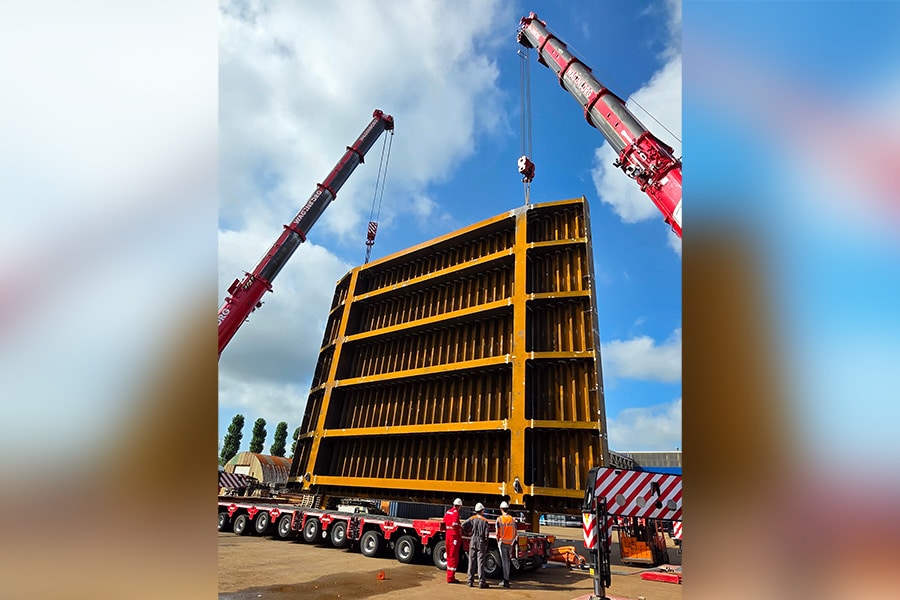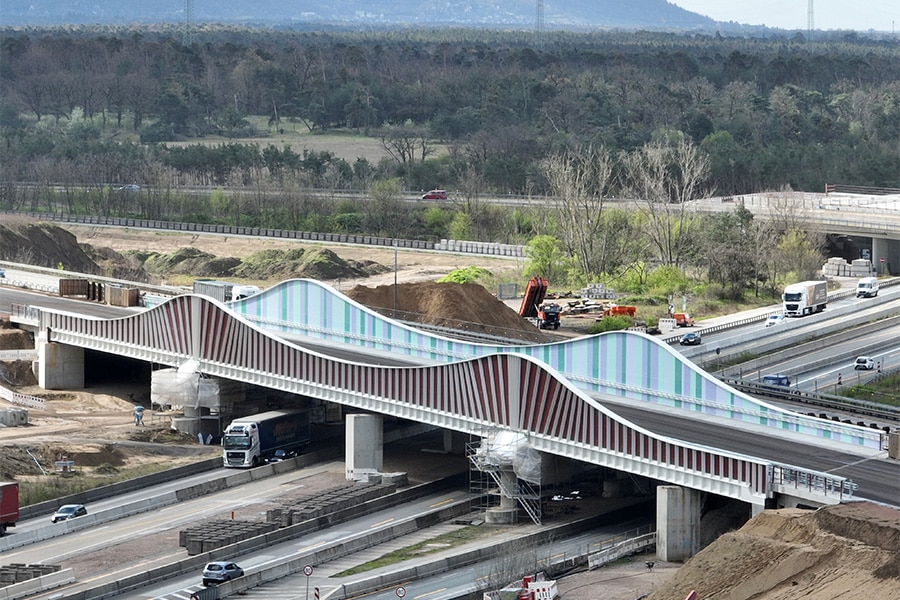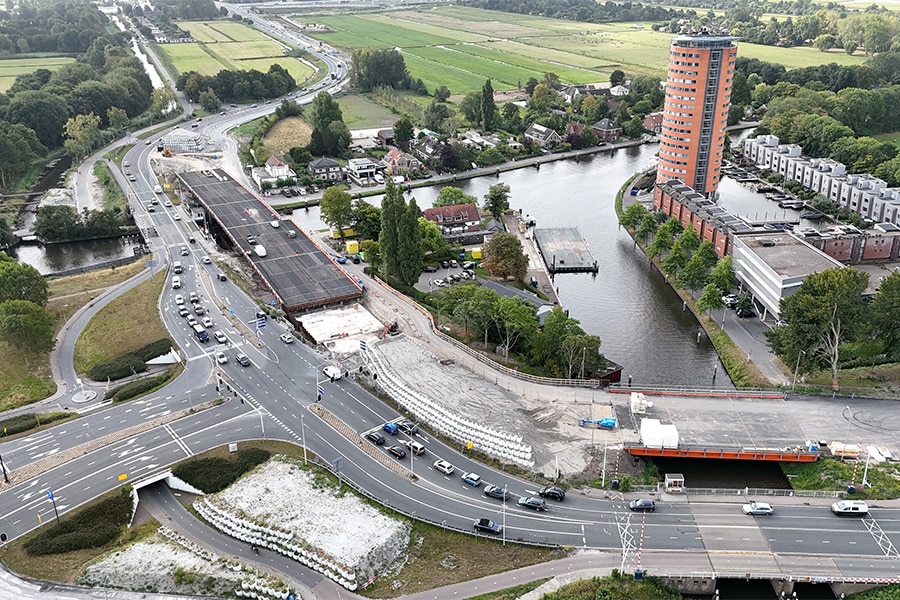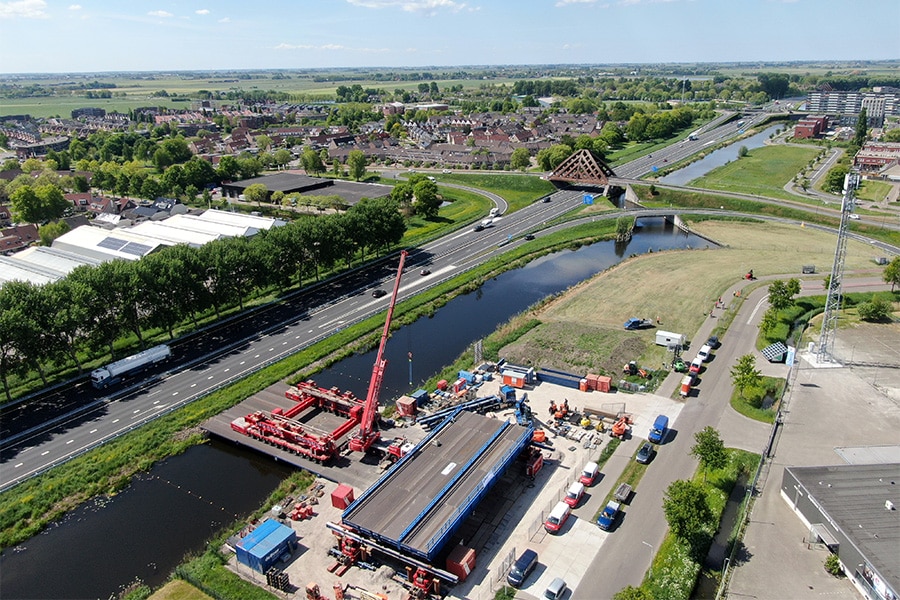
Smarter design through digitization at Rottemer Tunnel
Innovative way of working provides early insight and flexibility
Within project A16 Rotterdam is the construction of the Rottemerentunnel as a subproject. The tunnel is located in the connecting arch being realized between the A16 and the A13. The engineering of the tunnel is in the hands of BESIX. From the preliminary design, the BESIX engineering team saw the need for flexibility. Accordingly, BESIX opted for parametric design of the tunnel. Innovative and totally contemporary. Also, within the A16 Rotterdam project a digital twin, 'TWIN16', is used to create a digital ambition in which Virtual Reality and simulation are actively used to mitigate risks. We spoke with BESIX employees André de Groen, TWIN16 coordinator, Kenneth Wyns, design manager and Kelvin Roovers, computational designer, all working within the De Groene Boog construction consortium of the A16 Rotterdam project.

Considered mitigating risks as early as 2017
André explains, "Back in 2017, we were thinking about how to digitally mitigate risks at the Rottemer Tunnel. Where am I going to deploy a digital tool, was the question. The project involves a lot of info in different manifestations. How do we combine that? The idea arose to convert the 3D model to a virtual model. By involving parties early on in the design process, such as the fire department, we were able to show road traffic control how scenarios unfold. The national tunnel standard already provides how to approach stakeholders, we now do that even earlier visually in the design process. Thanks to these new tools, we interact very differently. Throughout the design process you encounter multiple phases, each with its own stakeholders. There has to be autonomous logic for 51 installations, we made the 3D model smart on this basis with adding the behavior of these 51 installations. We linked this smart world to the software of the operating and control system designed by Croonwolter&dros.

The software for the 51 installations was written by lead engineers and a total IFAT setup was made to test everything. The simulation is very representative of reality, everything runs according to the correct protocols. A virtual FAT test was also done, so not only with suppliers of the installations, but the simulation was also virtually validated."
A road safety audit already done in the design phase
Kenneth: "A road safety audit was done in the design phase, using images from the virtual model to support the road image analysis. This allowed us to demonstrate that the stop visibility at all points in the tunnel was sufficient at the eye level of car and truck drivers, and we were able to show that the signage fixed against the tunnel roof was fully visible from a sufficient distance for safe driving in the tunnel." André: "For the tunnel's digital twin, we worked with Infranea and Soltegro. We expect that using a digital twin will become a standard working method in the future. The new way of working affects the mindset of everyone involved, you have to be open to it. A digital twin should promote cooperation, you can only achieve this added value if the digital twin is placed at the heart of the process. We made a good start with TWIN-16, the digital twin of the Rottemer Tunnel. The challenge was to have the necessary information from the design process available in time to apply the digital tool successfully and on time."
Specific project conditions required flexibility
"Specific project conditions required flexibility in the design process," Kenneth outlines. "Not all soil testing could be done in advance, due to measures that still had to be taken, such as pond damping and tree clearing. Moreover, we knew that detailed information of suppliers' products, e.g. escape doors, would not be available until late, after purchasing these products. The very fact that there is a lot of repetition in building the tunnel legs made parametric design so interesting."
What does parametric design mean? Kelvin explains: "In parametric design, design processes are decomposed into algorithms that produce desired digital products based on parametric data and relationships between various components in a highly standardized and automated manner. A typical product is a parametric 3D model that adapts quickly and easily when the initial parameters change. The advantage of parametric design is that if something changes somewhere, the change is made in other locations as well. That saves a lot of engineering hours. It allows you to complete a design process faster and creates space for testing alternative scenarios. Experts no longer have to worry about re-entering all the data when new insights are gained; the parametric process frees their hands for other matters. Parametric design also prevents errors that arise from people having to enter data. Parametric design allows you to anticipate changes that almost always come as a surprise to a project. Especially for work that is repetitive, like the Rottemer Tunnel, parametric design is particularly useful." Kelvin supported the various design phases from BESIX. This quest to optimize digital design processes was always encouraged and supported by the entire design team of De Groene Boog.
Model prepared from parametric design
"Given the 89 slots in the tunnel, there is a lot of repetition. But ... not everything is 100% the same and different boundary conditions may apply for each slot. That's why we applied parametric design from the early stages, because not everything was fixed in the design yet. To obtain the necessary flexibility and accuracy from the BIM model, it was important to create scripts ourselves. These scripts allowed us, using parametric building blocks, to automatically produce all structural elements and other repetitive parts in the tunnel model. Thanks to these same scripts, we were afterwards also able to quickly implement changes and alternatives and check them in 3D."
Kelvin cites the pile foundations as an example of the added value of this method: "Thousands of piles were placed in the model via logic. The positions, types and lengths were often changed based on subsurface data, which only became known later. With parametric design, you avoid having to do individual research for each moot." Kenneth adds: "Because of the quick insights from the parametric scripts, we were also able to predict potential clashes in the subsurface without the design already being final. That's how you get as early and as broad an understanding of the interfaces as possible, and as an engineer you can better anticipate variables." Kelvin: "Automation also promotes standardization. Thanks to the use of scripts for setting up the model, we could immediately also easily store the correct codes and other standard information (e.g. required for the TWIN16) in all tunnel elements. We also continued this way of working in a subsequent phase to produce the form drawings of the concrete structure in a largely automated and standardized manner."
Thinking differently
Kenneth notes that for BESIX, this is the first time parametric design has been applied on such a scale within a project. Kelvin responds, "For me as a computational designer, this way of working is a matter of course, but it is a challenge to get everyone on board. After all, it requires a different mindset: one has to anticipate future changes and completely figure out design processes into a logical roadmap that can be executed correctly by a "dumb" computer, regardless of the boundary conditions and exceptions that may arise. A well-thought-out algorithm is essential to ensure quality results." Kenneth: "In that sense, it really is change management. Sometimes you're more psychologist than engineer. We see that people with the greatest stake in the design process are the first to embrace the new way of working."
BESIX is happy to take on the role of pioneer and also has the right people on board for it. Finally, Kenneth says, "We are now teaching people to use these new tools for their own expertise. Besides the practical role BESIX has in a design process, we also want to contribute socially by sharing our knowledge about parametric design. It is a future-proof method that is going to bring its value in many more areas than what we have used it for now."




